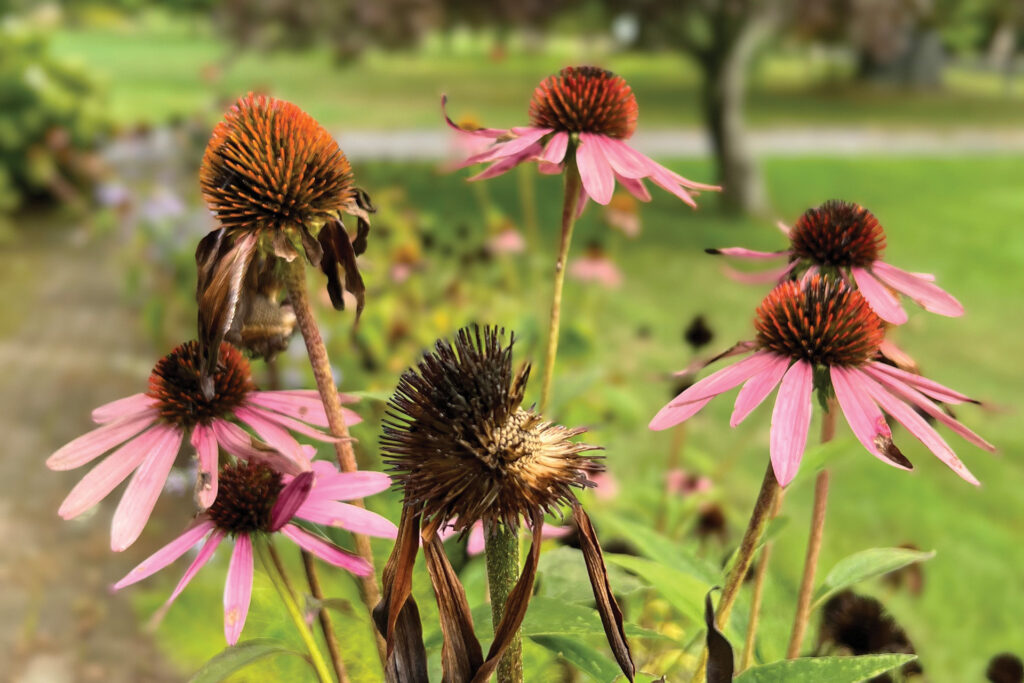Our resident horticulturist breaks it down for us.
By Mira Peck
When I graduated from The School of Professional Horticulture at The New York Botanical Garden more than a decade ago, I moved from Brooklyn up to the Hudson Valley and never looked back. I took a full-time gardening position at one of the largest estates in Dutchess County and fell completely in love with the view of the Catskills I saw every day. Currently living in Litchfield County, CT, nestled in the Litchfield Hills, I’m a designer for multiple properties, as well as a homeowner myself. I’m constantly inspired by the natural beauty of our region, and that passionately informs both my design and gardening ethos. The goal is always to be in alignment with nature.
But I know, that for many of us, fall cleanup in the garden brings up visions of noisy backpack blowers burning through a landscape, leaving immaculate and sterile garden beds in their wake, where every perennial is completely cut back to the ground and every single leaf put in a bag and unceremoniously carted away.
There’s definitely merit to this approach, but there are now legitimate questions to these practices being the only way.
Garden design has gone through many different fashions and styles. An aesthetic of clipped hedges, straight lines and highly groomed beds has its place, but I’m excited that today, the trend is moving toward a more ecological approach. Designs are more conscious about sustainability and climate change, focusing on diversity, complexity, utilizing native plants and supporting native pollinators. So too has garden maintenance moved in a direction that attempts to echo natural systems.
I’d like you to see the fall cleanup of your garden and your preparations for winter not just as an endless drudgery of tasks, but to see yourself as both an artist and a steward, learning how to read the landscape and create a point of view.
Just about everyone agrees that garden design is widely considered to be an art form—but garden maintenance?
When American master Jackson Pollock drizzled paint onto his canvas without using “proper” brushstrokes, he blew everyone’s mind—so, too, did Dutch garden designer, Piet Oudolf, when he instructed to leave spent flowers and seed heads in the garden over the winter, arguing that “brown is also a color.”
People were floored. Could we really do that? Here are some basic tenants of fall cleanup and why they’re done—plus some invitations to think about them differently:
Leaf Clearing
Leaves everywhere. Backpack blowers are actually a very efficient landscape management tool for clearing leaves, but we’re starting to question if we actually need to be so efficient in removing every single leaf. For example, from a sanitation perspective, removing the leaves from your garden does eliminate overwintering insects that can survive in the garden leaf litter; however, The Xerces Society actually recommends leaving leaf litter because it’s where many desirable insect pollinators overwinter. Leaves also act as nature’s mulch and fertilizer, insulating the ground and providing nutrients to the soil as worms and beneficial microbes break them down.
What I Do: Knowing this, I leave the leaves in my larger shrub beds at home. The winter winds create humps and hollows of them, and in spring I rake them flat to create an even layer. Ta-da! Free mulch. But yes, at this point I do remove most leaves from my more formal garden beds but keep the leaves on my property by feeding my hungry compost pile.
Perennial Cleanup
Cutting back all your perennials in the fall does save you time in spring, and it eliminates places for rodents to hide out and munch on your plants all winter—but leaving perennials up with their seed heads can also feed foraging birds and create beauty and inspiration during the stark winter months.
What I Do: I leave my echinacea flowers on, even as they turn brown, so I can watch goldfinches swoop in. I leave plants with sturdy stems or strong verticality such as Joe-Pye weed and panic grasses for “winter interest” because they look stunning as they glisten and sparkle on icy mornings. However, I do cut back all my floppy perennials and bushy clump grasses because voles are my nemeses and they love to hide there.
Pro Tip: Wait until perennials are yellow or brown before you cut them back; if they’re still green, they’re still photosynthesizing and feeding their roots.
Broadleaf Evergreens
Sometimes evergreens such as rhododendron suffer leaf desiccation. This is when their leaves dry out in the wind and turn brown because the plant can’t pull moisture up from the frozen ground.
What I Do: Make sure my broad-leaf evergreens are well hydrated going into winter. I even give them supplemental water if it’s a dry fall. In a professional setting, I might spray rhododendron and other plants including boxwood with Wilt-Pruf, an organic anti-desiccant, or wrap them in burlap, to prevent both desiccation and deer browsing.
Deer/Pest Pressure
You have to know your site and understand your winter pest pressure; even if you have a yard full of native plants, it will still require intervention before winter.
What I Do: Deer are a major issue for me, so I protect my small trees with wire fencing and spray my “deer candy” rhododendron with Plantskydd repellant.
Tubers & Bulbs
We all know fall is for bulb planting. Plant when the ground temperature is below 50 degrees, that’s when root growth starts and the bulbs can anchor in for the winter.
What I Do: I love growing my own local, organic cut flowers: daffodils and Allium are pretty much safe from everything, but I protect my tulip bulbs from rodents by either planting them in chicken wire “pillows” underground, or I add Repellex systemic capsaicin tablets to the soil. I plant bulbs all the way up through Thanksgiving most years. I also insulate my garlic bed with a four- to six-inch layer of shredded leaves. (I shred the leaves first by collecting a pile and then mowing over it with the lawn mower a couple of times. Leaves are so valuable—don’t throw them away.) I also make sure to dig up the tender tubers of my favorite dahlias and store them inside for the winter.
I know there’s a lot to do, but I encourage you to experiment with your normal fall cleanup routine. How can your maintenance practices be more aligned with nature? How can your landscape maintenance be an opportunity for artistic expression? It’s good to remember that just like every other time of year, winter garden preparations are just more dancing with nature—and maintenance decisions can also be artistic decisions.
Your environment—and our increasingly fragile planet—are definitely worth it.













Comments are closed.